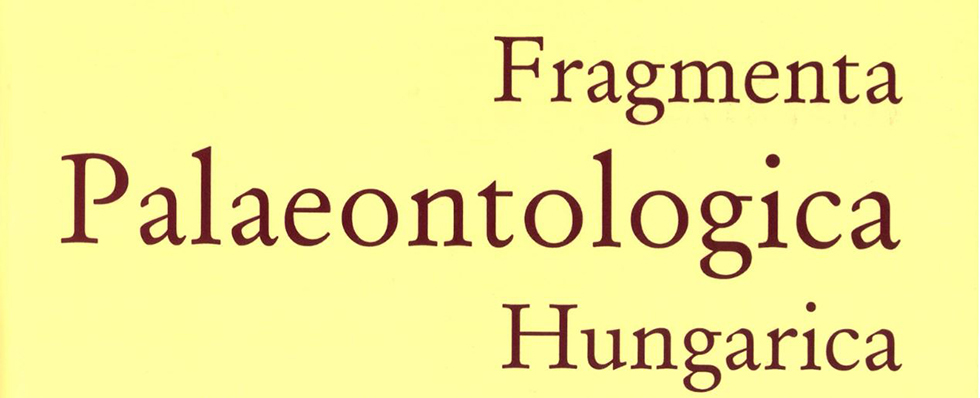Fragmenta Palaeontologica Hungarica publishes papers in fields of palaeontology and its interdisciplinary relations. Topic should be associated with the palaeontological research in Hungary (e.g., author, locality, depository of material, palaeobiogeographical or historical relations). Submission of a paper implies that it has not been published previously and is not under consideration for publication elsewhere.
Periodicity: Volumes published yearly by the Hungarian Natural History Museum. The online version of the articles will be published in the order in which they are received, after reviewing and editing.
Deadline for submitting manuscripts: Manuscripts can be submitted continuously and should be sent to the editor (A. Dulai). In case of multiple authors, corresponding author should be indicated.
Editing, referees: All papers will be sent to referees for peer review by the editorial board. Authors should submit the names, addresses and e-mail addresses of three authorities whose expertise makes them suited to review the paper. Authors should give a suggestion for a running heading.
Preparation of manuscripts (please, consult also the last volume of the journal): Fragmenta Palaeontologica Hungarica prefers manuscripts of paper size or parts of series. Papers must be written in English with British spelling.
Suggested construction of the manuscripts (underlined: obligatory component):
Title should be followed by names and full address(es) of Author(s), including e-mail(s). Abstract should be a brief summary of the contents and conclusions of the paper (without references), and should be no longer than 200 words. At the end, please give the number of figures and tables.
Keywords should not be more than ten key word entries in alphabetic order. Do not repeat words in the title.
Usual sections of the manuscripts are: Introduction, Geological settings/Localities, Material, Methods, Main part of the paper with optional subtitles, Conclusions, Acknowledgements, References, Figure captions, Plate captions, Figures and Plates.
Acknowledgements section should be less than 10 lines.
Text: Manuscript should be submitted in electronic file of Word or Rich Text Format (double spaced in Times New Roman and 12 pt). Genus and species level names are to be typed in Italics. Authors in citations must be in Small Caps. Format: d’Orbigny (1850, 1852), (d’Orbigny 1850, 1852; Dumortier 1874), Morris & Cleevely (1981), or Preston et al. (1996). No further editing requested in the text disregarding titles and paragraphs. Avoid multiple spaces and points. Do not type tabs outside tables. Between numerals use en dash (–), not a hyphen (-). Do not use Format Bullets and Line Numbering. Use only standard abbreviations; arbitrary abbreviations if needed, should be explained in the Introduction. Footnotes, or other special formatting should be avoided.
Figures: All necessary illustrations and tables should accompany the manuscript, but should not be inserted in the text. They should be numbered consecutively in Arabic numerals in the order in which they are referred to in the text. Please, prepare all illustrations electronically in high quality (line drawings scanned at 600 dpi, half tone at 300 dpi), they can be prepared in colour. Size of illustrations: 1:1 to printable form or proportionally larger; “portrait” format preferred for full-page illustration. Digital figures should be submitted in .TIFF, .JPEG or .PSD files. Explanation of lettering and symbols should be given in the figure and table captions, which are submitted in the text, after the list of references.
Maximal printable size of illustrations (full page): 125×180 mm; please, plan them to be economically suitable; lettering and symbols to appear on the illustration should be of sufficient size to allow for considerable reduction where necessary. Use at least 14 pt Bold letters to identify elements in the illustrations. Scales, if necessary, should be indicated on micrographs, in metric system. File names should indicate the authors and the correct numbers, e.g. X_Y_Fragmenta_Fig1.tif.
References: References include exclusively those publications that are cited in the text (which includes captions to figures, plates and tables, however, does not include authorship of taxa). Titles of journals must be given in full and are italicised, as are titles of books. Volume numbers of journals are bold. In the text references should be given as Vörös (2009) or (Vörös 2009). When a citation includes more than two authors, e.g. Dulai, Gasparik, Szentesi & Pálfy, the paper should be referred to in the text as Dulai et al. If papers by the same author(s) in the same year are cited, they should be distinguished by the letters, a, b, c, etc., e.g. Emig (1997a). References to papers “in press” must mean that the article has been accepted for publication. References to “personal communications” and unpublished work are permitted in the text only: references to papers in preparation or submitted are not permissible.
Hall C. A. 1964: Middle Miocene Conus (Class Gastropoda) from Piedmont, northern Italy. –Bollettino della Società Paleontologica Italiana 3(2): 111–171.
McKenna M. & Bell S. 1997: Classification of Mammals Above the Species Level. – Columbia University Press, New York, 631 pp.
Emig C. C. 1997a: Biogeography of inarticulated brachiopods. – In: R. L. Kaesler (ed.): Treatise on Invertebrate Paleontology, Part H, Brachiopoda revised 1: 497–502. Geological Society of America and University of Kansas, Boulder and Lawrence.
Page proofs and reprints: Page proofs will be sent as PDF files to the (corresponding) author for checking. They are particularly requested to return their corrected proofs as quickly as possible (preferably within 10 days). Free e-reprint (PDF file) for personal use and own distribution will be sent to the (corresponding) author.
For additional information, contact the editor: Dr. Alfréd Dulai, Department of Palaeontology and Geology, Hungarian Natural History Museum, 1431 Budapest, Pf. 137. E-mail: dulai.alfred@nhmus.hu
